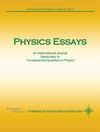A physical mechanism of the generation of stable positive kinetic energy systems and a qualitative explanation of the proportions of the four ingredients in the universe
IF 0.5
Q4 PHYSICS, MULTIDISCIPLINARY
引用次数: 0
Abstract
The author’s opinion is that the negative energy solutions of the Dirac equation mean that a particle can be of negative kinetic energy (NKE) besides positive kinetic energy (PKE). We think that NKE particles are dark ones, and NKE matter is dark matter. In our previous works, the dark matter theory of the NKE version and the dark energy theory that matched the dark matter theory were put forth. In this work, we investigate the topics related to the metamorphosis of objects between PKE and NKE. We first evaluate the collisions between a PKE and a NKE particles. A scenario of accelerating PKE particles is raised. We put forth the cosmic dark radiation background and gravity potential background. In the universe, negative energy is predominating. In the observable universe, substances constitute stable PKE systems. The total energy of every such system is negative. We propose a mechanism that NKE substances combine into stable PKE systems. Macroscopically, NKE objects can constitute stable PKE astrophysical systems by means of gravity between them. Microscopically, NKE particles can combine into stable PKE systems by means of attractive interactions between them, say, Coulomb attraction. Currently, people think that there are four ingredients in the universe: Photons ΩR0, matter ΩM0, dark matter ΩDM, and dark energy ΩΛ0. We analyze the order of the appearance of the four ingredients and conclude that qualitatively, their proportions should be产生稳定正动能系统的物理机制,以及对宇宙中四种成分比例的定性解释
笔者认为,狄拉克方程的负能量解意味着粒子除了具有正动能(PKE)之外,还可以具有负动能(NKE)。我们认为负动能粒子就是暗粒子,负动能物质就是暗物质。在我们以前的工作中,提出了 NKE 版本的暗物质理论和与暗物质理论相匹配的暗能量理论。在这项工作中,我们研究了天体在 PKE 和 NKE 之间蜕变的相关课题。我们首先评估了PKE粒子和NKE粒子之间的碰撞。我们提出了一种 PKE 粒子加速的情形。我们提出了宇宙暗辐射背景和重力势能背景。在宇宙中,负能量占主导地位。在可观测的宇宙中,各种物质构成了稳定的 PKE 系统。每个这样的系统的总能量都是负的。我们提出了一种 NKE 物质结合成稳定 PKE 系统的机制。从宏观上看,NKE 物体可以通过它们之间的引力构成稳定的 PKE 天体物理系统。微观上,NKE粒子可以通过它们之间的吸引力相互作用(如库仑吸引力)结合成稳定的PKE系统。目前,人们认为宇宙中有四种成分:光子ΩR0、物质ΩM0、暗物质ΩDM和暗能量ΩΛ0。我们分析了这四种成分出现的先后顺序,得出的定性结论是,它们的比例应该是 ΩΛ0>ΩDM0>ΩM0>ΩR0。
本文章由计算机程序翻译,如有差异,请以英文原文为准。
求助全文
约1分钟内获得全文
求助全文
来源期刊

Physics Essays
PHYSICS, MULTIDISCIPLINARY-
自引率
83.30%
发文量
50
审稿时长
6-12 weeks
期刊介绍:
Physics Essays has been established as an international journal dedicated to theoretical and experimental aspects of fundamental problems in Physics and, generally, to the advancement of basic knowledge of Physics. The Journal’s mandate is to publish rigorous and methodological examinations of past, current, and advanced concepts, methods and results in physics research. Physics Essays dedicates itself to the publication of stimulating exploratory, and original papers in a variety of physics disciplines, such as spectroscopy, quantum mechanics, particle physics, electromagnetic theory, astrophysics, space physics, mathematical methods in physics, plasma physics, philosophical aspects of physics, chemical physics, and relativity.
 求助内容:
求助内容: 应助结果提醒方式:
应助结果提醒方式:


